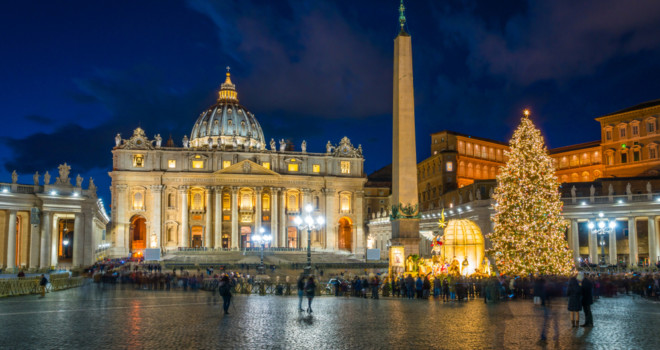I will always remember the religious sisters who sat in front of me during the Easter Vigil at St. Peter’s. As soon as they entered the basilica, they began taking pictures, pointing out their favorite works of art, and excitedly hugging one another. They laughed. They smiled. They marveled at everything. Truly, it was a delight to watch.
The Vatican inspires, if not this kind of joyful wonder, at least a sense of awe. Even non-Catholics are enamored with Vatican lore. The glory and the beauty of the cradle of Catholicism are marvelously displayed in the new Vatican Christmas Cookbook, written by chef and former Swiss Guard David Geisser and published by Sophia Institute Press. The cookbook will capture the imagination of both curious observers and devout Catholics and, I hope, may evoke a little of the excitement and wonder I saw in the sisters at the Vigil.

Like its bestselling predecessor, which was released in 2016, The Vatican Christmas Cookbook shares recipes for dishes enjoyed by the popes and their protectors, the storied Swiss Guard. Alongside instructions for veal chanterelle, filet mignon with racy pepper sauce, and dark Toblerone mousse, readers find mouthwatering photos and interesting tidbits about what may be unfamiliar fare. The book also includes stories of Vatican Christmases down through the ages, beginning with Leo the Great, “the pope who saved Christmas” with his famous sermon on the significance of the Savior’s birth. (Allegedly, Pope Leo was also the first pontiff to preach about the season of Advent.)
Having an insatiable curiosity about all things international, I enjoyed reading Geisser’s descriptions of Christmas traditions around the world. I didn’t know that in the Philippines, for instance, the Christmas season ends with a procession in honor of the Black Nazarene, a wooden statue of a dark-skinned Jesus carrying His Cross. And in Argentina, since Christmas takes place in the summer, people celebrate by having barbeques. I was also interested to learn that in Egypt, as in America, children leave out cookies for Santa Claus, known as Baba Noël in Arabic. It’s fun to find common threads like these in different cultures.
I’ll note two faults some readers may find with The Vatican Christmas Cookbook. First, some recipes don’t fit the Christmas theme. Specifically, I was a bit puzzled to find a recipe for fajitas Argentine. According to the introduction, Geisser chose this recipe because fajitas are served in a communal style, meant to “encourage and emphasize the human touch.” As far as I know, however, Argentines don’t traditionally eat fajitas at Christmas (or, in fact, at all). A better choice might have been a recipe for canapes navideños, bite-sized hors d’oeuvres briefly mentioned in the cookbook’s section on Christmas in Argentina.
The second issue readers may find is that certain recipes call for ingredients that may be expensive or hard to find, such as lavender honey and truffle oil. I actually didn’t mind this. Indeed, I’d expect to find fancy ingredients in a Vatican-themed cookbook, especially one that focuses on the holidays. Luxury, or at least the appearance thereof, is part of what draws people to the Vatican and stirs in them the sense of wonder I described in my anecdote about the Easter Vigil.
In summary, The Vatican Christmas Cookbook is a feast for the imagination. That’s why, like me, many people might especially enjoy reading it during this difficult holiday season. In painful times, the imagination is more than a means of lighthearted amusement; it is a powerful source of hope, a way of beholding a happier future. I can’t go home for Christmas this year, but I can flip through a beautiful cookbook and imagine making pumpkin soup amaretto for my family when it’s safe to travel again. I can envision a time when we can, in Geisser’s words, “gather close to each other, pass the vittles and plates from one to another, talk and laugh, enjoy the human moment with food as companion.” This thought fills me with joy and anticipation, which are no small gifts in this chaotic time.
✠
Author’s note: In the interest of transparency, I’ll note that I work for Sophia Institute Press as a freelance editor, although I did not work on The Vatican Christmas Cookbook.
The Vatican Cookbook is available as an ebook or paperback from your favorite bookseller or online through Sophia Institute Press.












